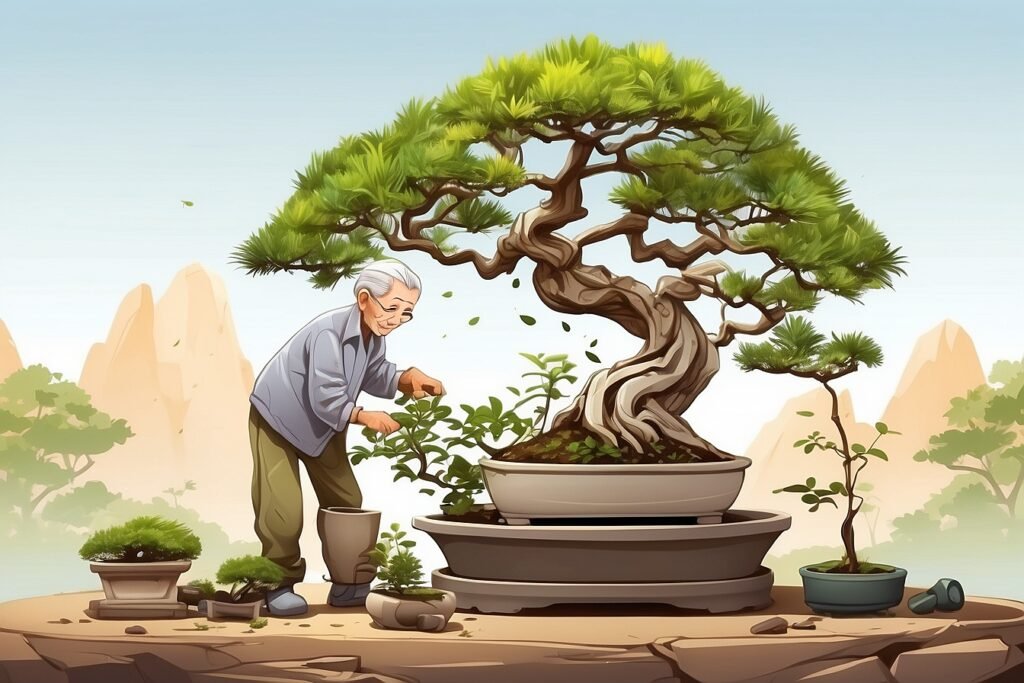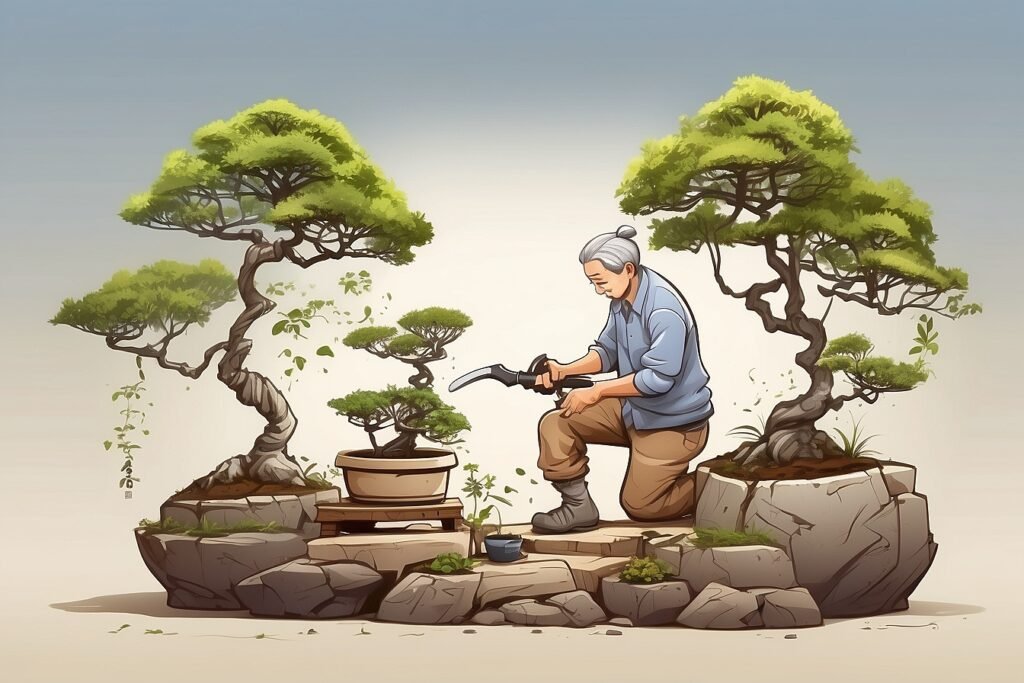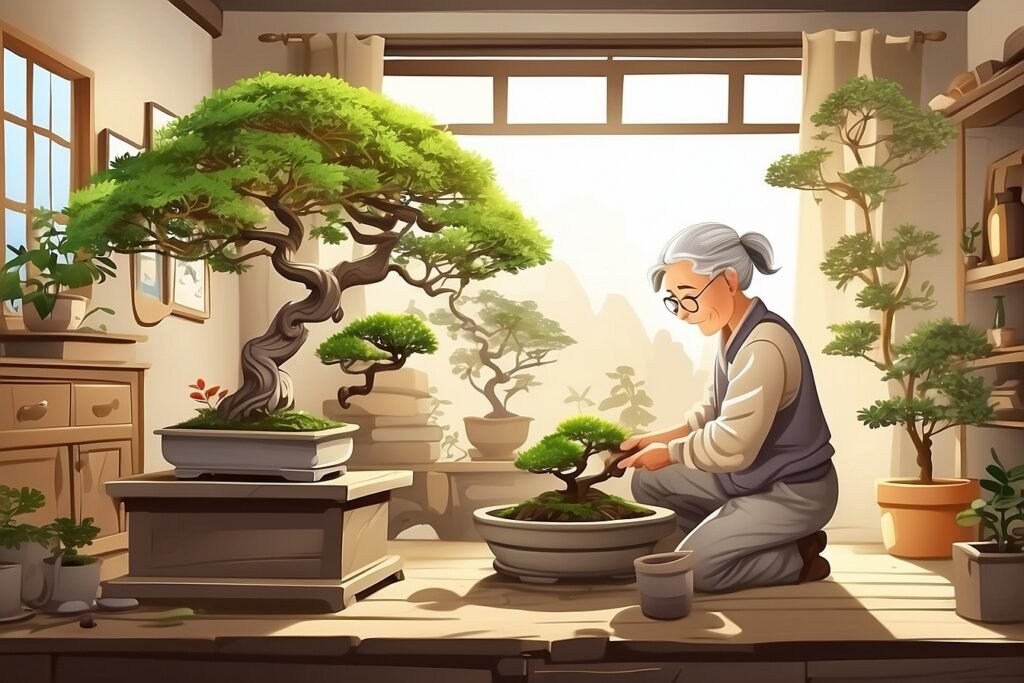Introduction
The Japanese Black Pine Bonsai is a popular choice for bonsai enthusiasts due to its unique shape, slow growth rate, and long lifespan. Let’s discuss how to grow and care for this bonsai.

| Aspect | Details |
|---|---|
| Tree Variety | Japanese Black Pine |
| Growth Rate | Slow |
| Indoor Care | Requires proper care and attention |
| Lighting | Position in a window with direct afternoon sunlight |
| Humidity | Maintain semi-humid environment with humidity tray or regular misting |
| Temperature | Ideal range is between 50 and 70 degrees Fahrenheit |
| Soil | Well-draining soil mix for good root health |
| Watering | Water when soil is dry to the touch, avoid over-watering |
| Fertilizing | Use balanced fertilizer every two weeks during growing season |
| Repotting | Every 2-3 years for young trees, every 3-5 years for older trees |
| Pruning | Prune in late winter or early spring before new growth begins |
| Branch Training | Wire and train branches to create desired shape, avoiding bark damage |
| Styles | Formal upright, informal upright, cascading |
| Pinching and Tipping | Use sparingly to encourage compact growth |
| Lifespan | Long-lived, with a lifespan of 100-200 years in the wild |
Follow these guidelines to grow a healthy Japanese Black Pine Bonsai. Remember to be patient and pay attention to details for a fulfilling bonsai cultivation journey.
Historical Context Japanese Black Pine Bonsai

Bonsai Cultivation and the Prominence of Japanese Black Pine
Bonsai cultivation is a traditional and extremely rooted practice in Japanese culture, with origins in the Chinese penjing tradition. The Japanese refined it over time, resulting in the unique styles and techniques associated with bonsai today.
The Japanese Black Pine (Pinus thunbergii) is a popular choice for bonsai cultivation due to its adaptability and strength. Its long dark green needles grow in collections of two and it can fight extreme conditions, making it ideal for the tough work of bonsai.
The Japanese Black Pine is a slow-growing tree, often used in bonsai practice. It can live up to 100-200 years and is styled in formal upright, informal upright, and cascading styles. It is considered the most iconic conifer in bonsai practice and is known as the king of bonsai.
The Cultural Significance of the Japanese Black Pine
The Japanese Black Pine holds great significance in Japan as it is considered a symbol of strength and longevity. It is also a popular bonsai tree that requires special attention to detail.
This includes placing it in full sunlight, monitoring the humidity and temperature, watering regularly, fertilizing, repotting, pruning, and training. Despite being a strong tree, it can still be sensitive to various pests and diseases.
However, with proper care and attention, these challenges can be overcome. The art of growing bonsai reflects the principles of patience, perseverance, and living in harmony with nature, all of which are central to Zen Buddhism.
The Anatomy of the Japanese Black Pine

Physical Features and Growth Patterns
The Japanese Black Pine is a needled pine tree with dark bark and long, hard, dark green needles that grow in sets of two. Its unique shape and slow growth rate make it perfect for bonsai cultivation.
Key features include:
- Inflexible needled pine tree with dark bark and dark green needles.
- Unique shape with slow growth rate.
- Long, dark green, hard needles in clusters of two.
- Ability to lose its first bloom of growth and greenery due to storms, but quickly produces a second bloom.
- Can grow up to 3 feet per year, but we keep them much smaller.
- Ability to produce shorter needles and smaller shoots.
| Physical Features | Growth Patterns |
|---|---|
| Stiff needled pine tree with dark bark and dark green needles. | Can grow up to 3 feet per year, but bonsai growers keep them much smaller. |
| Unique shape with slow growth rate. | Ability to produce shorter needles and smaller shoots. |
| Long, dark green, hard needles in clusters of two. | Pruning, wiring, and shaping techniques can be used to create desired bonsai styles. |
| Can lose its first flush of growth and foliage due to storms, but quickly produces a second flush. |
The Appeal of the Japanese Black Pine as a Bonsai Tree
The Japanese Black Pine is an ideal bonsai tree due to its unique physical features and growth patterns. Its dark bark and stiff needles contrast beautifully with the delicate artistry of bonsai cultivation. Its slow growth rate allows for thoughtful shaping over time, while its resilience makes it ideal for challenging conditions.
Additionally, its shorter needles and smaller shoots provide great options for detailed pruning and shaping, allowing for a variety of styles. Overall, the Japanese Black Pine is a rewarding choice for bonsai enthusiasts of any experience level.
Cultivation Techniques: From Seedling to Bonsai
Learn how to cultivate a Japanese Black Pine bonsai with our step-by-step guide that covers everything from choosing a seedling to proper shaping and pruning techniques.

Step 1: Selecting a Seedling
To begin growing a Japanese Black Pine bonsai, choose a healthy seedling with a sturdy trunk, vibrant needles, and no signs of pests or disease.
Step 2: Positioning and Caring for Your Bonsai
The Japanese Black Pine bonsai should be kept outdoors throughout the year, with protection from intense weather conditions. Good watering is crucial, and the soil must not dry out completely. If you need to bring it indoors, use a humidity tray to maintain the required moisture levels.
Step 3: Fertilizing Your Bonsai
During the growing season, add a slow-release fertilizer to the soil every 1-2 months. This will provide the nutrients your bonsai needs to blossom.
Step 4: Repotting Your Bonsai
Repot deciduous trees every 2-3 years and evergreens like Japanese Black Pine every 4-5 years. Trim no more than 1/3rd of the root mass while repotting for easy recovery.
Step 5: Dealing with Pests
If you notice pests on your bonsai, treat them quickly using smaller and more delicate doses of treatment than you would for a full-sized tree.
Maintaining the Health and Aesthetics of Your Bonsai

Tips on How to Maintain the Health of a Japanese Black Pine Bonsai
Please consider its needs and surroundings to keep your Japanese Black Pine bonsai healthy. Follow these tips to ensure its blossoming:
- Outdoor Arrangement: Keep the bonsai outside year-round, but protect it from severe winter freezes and shield it from strong winds and sun exposure throughout the year.
- Watering: Regularly water the tree, especially in winter and when the soil appears dry. Don’t let the soil become completely dry.
- Humidity Tray: If you need to bring the bonsai indoors, use a humidity tray to maintain the necessary moisture levels.
- Fertilizer: Apply a slow-release fertilizer every 1-2 months during the growing season.
- Pruning: Trim back new growth to the most distant safe point to help the trunk grow thicker.
- Repotting: Repot deciduous trees every 2-3 years and evergreens like the Japanese Black Pine every 4-5 years, preferably in mid-summer.
- Pest Control: Use a smaller and gentler treatment dose for the tree to address any pest issues.
The Importance of Yearly Cleanup to Ensure Optimal Growth and Aesthetics
To ensure the best growth and appearance of your bonsai tree, it’s essential to perform a yearly cleanup.
This involves:
- Removing Dead Branches: This promotes air circulation and prevents overcrowding.
- Sunlight Penetration: Regular pruning and trimming allow for better sunlight penetration.
- Risk Reduction: Cleanup reduces the risk of pests and diseases.
- Weed and Debris Removal: Keep the pot and soil surface clean to prevent the growth of unwanted plants.
Exploring the Use of a Sacrifice Branch in Developing a Japanese Black Pine Bonsai
The use of a sacrifice branch is a strategic technique in bonsai development:
- Purpose: Allowing the sacrifice branch to grow freely enhances the growth of the trunk by absorbing more nutrients and energy.
- Outcome: Once the trunk has reached the desired thickness, the sacrifice branch can be pruned or removed.
- Management: This technique requires careful monitoring to ensure the sacrifice branch does not dominate the tree’s growth or create imbalances.
Common Challenges and Solutions
Common Challenges in Cultivating a Japanese Black Pine Bonsai and Practical Solutions
Cultivating a Japanese Black Pine bonsai can come with its own set of challenges. However, with the right approach, these challenges can be effectively managed. Here are some common issues and their respective solutions:
| Common Challenges | Solutions |
|---|---|
| Difficulties in rooting cuttings | It’s best to grow Japanese Black Pine bonsai from seeds or through grafting and air-layering, rather than using cuttings. |
| Pruning and training | To shape a bonsai as desired, prune and wire its branches regularly. However, while wiring, be careful not to harm the bark. |
| Disease and pest management | To maintain the health of a bonsai tree and prevent pest infestation, ensure it’s placed in a sunny spot, watered sufficiently, and fertilized regularly. Use proper pesticides, or you can comment below in case of disease or infestation. |
Conclusion
This guide provides detailed information on cultivating a Japanese Black Pine bonsai tree. It’s not advisable to grow these bonsai trees from cuttings. Instead, techniques such as growing from seeds or grafting are recommended. The guide covers essential factors like positioning, light and temperature needs, humidity, soil type, watering frequency, fertilizing, and repotting.
It also explores various bonsai styles suitable for a Japanese Black Pine and shares effective techniques for shaping your bonsai tree. The journey of cultivating a Japanese Black Pine bonsai tree is rewarding, offering unique insights and experiences.
With this guide’s knowledge and guidelines, you’re equipped to embark on this journey and witness a masterpiece unfold before your eyes.
FAQs
Can Japanese Black Pine grow from cuttings?
While it is technically possible to propagate a Japanese Black Pine from cuttings, it’s generally not recommended due to the low success rate. Instead, consider growing from seeds or grafting for better results.
How fast does Japanese Black Pine grow?
Japanese Black Pine trees have a moderate growth rate. In ideal conditions, they can grow up to 12 inches per year. However, as bonsai, their growth rate will be significantly slower due to the restricted root space and meticulous pruning.
Can you grow Japanese Black Pine indoors?
Japanese Black Pine bonsai trees thrive best outdoors where they can receive full sun and experience natural seasonal changes. However, they can be brought indoors temporarily for display purposes, provided they are returned outdoors promptly to ensure their health.
How long do Japanese Black Pines live?
Japanese Black Pines are long-lived trees. In their natural habitat, they can live for several hundred years. As bonsai, with proper care, they can easily live for many decades.
How do you thicken Japanese Black Pine?
Thickening a Japanese Black Pine involves allowing branches, particularly lower ones, to grow freely. This technique, known as “sacrifice branches,” can help to increase trunk girth over time.
How to bonsai Japanese Black Pine?
Bonsai-ing a Japanese Black Pine involves several steps like selecting a healthy tree, deciding on a bonsai style, regular pruning and training, and ongoing care including watering, fertilizing, and repotting.
Japanese Black Pine styling?
There are various bonsai styles suitable for a Japanese Black Pine, including formal upright, informal upright, slanting, semi-cascade, and group planting. The final choice depends on the natural growth habit of your specific tree and your personal preference.
Japanese Black Pine pruning and training?
Pruning and training are essential for maintaining the aesthetic appeal of your bonsai. Pruning involves removing unwanted branches and needles to shape the tree, while training involves wiring the branches to guide their growth in a particular direction.
Japanese Black Pine bonsai care guide?
Caring for a Japanese Black Pine bonsai involves regular watering (but not overwatering), fertilizing during the growing season, repotting every 2-3 years, and protecting against pests and diseases. It also requires plenty of sunlight and well-drained soil.
When to repot Japanese Black Pine?
Japanese Black Pine bonsai trees should generally be repotted every 2-3 years. However, the exact timing can depend on factors like the age of the tree, the size of the pot, and the rate of growth. Repotting is usually done in early spring, just before the new growth starts.
Further Reading and Resources
- The Ultimate Guide to Norfolk Island Pine Bonsai Care: Expert Tips and Techniques
- Mastering the Art of Growing Birch Bonsai (Betula): A Comprehensive Guide
- Alberta Spruce Bonsai: A Detailed Guide to Pruning, Growth, and Maintenance
- The Comprehensive Guide to Caring for Your Mugo Pine Bonsai
- Mastering the Art of Growing Bonsai Banana Trees: A Comprehensive Guide
- Mastering the Art of Growing Bonsai Banana Trees: A Comprehensive Guide
Other Sources:
- Selective Decandling and Cutback of a Japanese Black Pine
- Japanese Black Pine, ‘Arakawa’ update – Nebari Bonsai
- Fall Cleanup of a Large Japanese Black Pine





